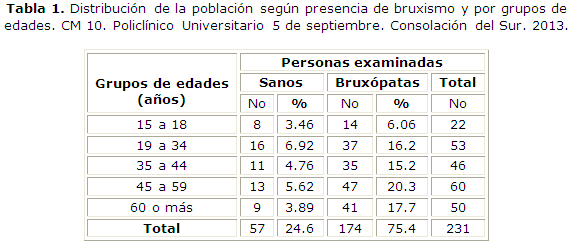Bruxism: its behavior in a health area
Keywords:
Bruxism/epidemiology, Habits.Abstract
Introduction:bruxism is the habit of grinding and clenching the teeth with movements making contact, not including functional purposes during both day and night, without being aware.Objective: to characterize the behavior of bruxism in a health area of Consolacion del Sur municipality, Pinar del Río.
Material and Method: an observational, descriptive and cross-sectional study was conducted at No-10 the family doctor's office belonging to 5 de Septiembre University Polyclinic in Consolacion del Sur municipality during 2013. The target group included 1115 inhabitants and for the sample the selection was made through a simple random sampling comprising 231 patients who underwent an interview which included a questionnaire and a clinical examination.
Results: a high prevalence of bruxism affecting 75.4% of the study population was observed and the most affected ages 45-59 years, female gender was the most affected (4.2%) and the directives were the most affected according to the occupational level and represented 28.1%. The most predominant sign was the nonfunctional wear facets (100%) in people prone to this condition, followed by temporomandibular-joint (TMJ) disorders in 47.1%; while pain in the TMJ (32.6%) was the most common symptom.
Conclusions: the presence of bruxism in the population was high. Female gender was the most affected. The predominant signs were the not functional wear facets and the prevailing symptom was pain in the temporomandibular joint.
Downloads
References
1. Byrd KE, Romito LM, Dzemidzic M, Wong D, Talavage TM. FMRI study of brain activity elicited by oral parafunctional movements. J Oral Rehabil. [Internet]. 2009 [citado 2014 Ene 16]; 36(5): [Aprox. 15 p.]. Disponible en: http://onlinelibrary.wiley.com/doi/10.1111/j.1365-2842.2009.01947.x/full
2. Díaz Gómez SM, Díaz Mirallesn M, Nápoles González I de J, Puig Capote E, Ley Sifontes L. Bruxismo: acercamiento a un fenómeno creciente. AMC [Internet]. 2009 [citado 2014 Abr 07]; 13(2): Disponible en: http://scielo.sld.cu/scielo.php?pid=S1025-02552009000200018&script=sci_arttext
3. Torres Márquez PA, Clavería Ríos FA, Fuentes González M de la C, Torres López LB, Crespo Mafrán MI. Uso de férula de descarga en una paciente con bruxismo. MEDISAN [Internet]. 2009 [citado 2014 Jun 07]; 13(4): [aprox. 9 p.]. Disponible en: http://scielo.sld.cu/scielo.php?script=sci_arttext&pid=S1029-30192009000400015
4. Moncada L A, Gallardo IR, Aguilar LM, Conejan CN, Dreyer EA, Gonzalo Rojas A. Bruxómanos presentan un estilo de personalidad distintivo. Rev. chil. neuro-psiquiatr. [Internet]. 2009 Jun [citado 2012 May 07]; 47(2): [aprox. 20 p.]. Disponible en: http://www.scielo.cl/scielo.php?pid=S0717-92272009000200002&script=sci_arttext&tlng=e
5. Montero Parrilla JM, Jiménez Quintana Z. Rehabilitación ocluso-articular en un paciente bruxópata. Rev. Cubana Estomatol [Internet]. 2011 [citado 2014 Jun 07]; 48(3): [Aprox. 10 p.]. Disponible en: http://scielo.sld.cu/scielo.php?pid=S0034-75072011000300011&script=sci_arttext
6. Armas Bermudez A, Latorre C, Pallenzona MV, Guiza E. Desgaste dental y factores de riesgo asociados.Rev. CES Odonto. [Internet]. 2010 [citado 2014 Jun 07]; 23(1): [aprox. 1 p.]. Disponible en: http://bdigital.ces.edu.co/ojs/index.php/odontologia /article/view/755/749
7. Morales A L, Mora Pérez C de la C, Álvarez Rosa I, Orbea González M, Fernández Martínez J, Rodríguez López J A et al. Bruxismo y funcionamiento familiar en niños de 5 a 11 años. Facultad de Ciencias Médicas de Cienfuegos, Cuba. MediSur [Internet].2009 [citado 2014 Jun 07]; 7(1):[Aprox.6 p.]. Disponible en: http://medisur.sld.cu/index.php/medisur/article/viewArticle/491
8. Ferreira Bacci V, Cardoso CL, do Cardoso A , Díaz Serrano KV. Behavioral problems and emotional stress in children with bruxism. Ribeirão Preto . Braz. Dent. J. [Internet].2012 [citado 2014 Jun 07]; 23 (3): [Aprox. 4 p.]. Disponible en: http://www.scielo.br/scielo.php?script=sci_arttext&nrm=iso&lng=es&tlng=es&pid=S0103-64402012000300011
9. Godoy LF, Palacio AV, Naranjo M. Acción e influencia del bruxismo sobre el sistema masticatorio: Revisión de literatura. CES Odonto. [Internet]. 2008 [citado 2014 Jun 07]; 21(1): [aprox. 1 p.]. Disponible en: http://bdigital.ces.edu.co/ojs/index.php /odontologia/article/view/53/43
10. Gama E, de Oliveira Andrade A, Marques Campos R. Bruxismo: Uma revisão da literatura. Ciência Atual. Gama.Rev.Cientifica Multidisciplinar das Facudades Sao Jose.[Internet]. 2013 [citado 2014 Jun 16]; 1(1): [Aprox. 6 p.]. Disponible en: http://inseer.ibict.br/cafsj/index.php/cafsj/article/view/2/pdf
11. Cabrera Villalobos Y, Álvarez Llanes M, Gómez Mariño M, Malcom Castillo M E. Oclusión y estrés en el síndrome dolor-disfunción temporomandibular: presentación de un paciente. Rev. Archivo Médico Camaguey . AMC. [Internet]. 2009 Jun [citado 2014 May13]; 13(3): Disponible en: http://scielo.sld.cu/scielo.php?pid=S1025-02552009000300018&script=sci_arttext
12. Peñón Vivas PÁ, Grau León I, Sarracent Pérez H. Caracterización clínica del síndrome de disfunción temporomandibular en el Hospital Universitario "Miguel Enríquez". Rev. Cubana Estomatol [Internet]. 2011 [citado 2014 May 13]; 48(4): [Aprox. 3 p.].Disponible en: http://scielo.sld.cu/scielo.php?pid=S0034-75072011000400008&script=sci_arttext

Published
How to Cite
Issue
Section
License
Authors who have publications with this journal agree to the following terms: Authors will retain their copyrights and grant the journal the right of first publication of their work, which will be publication of their work, which will be simultaneously subject to the Creative Commons Attribution License (CC-BY-NC 4.0) that allows third parties to share the work as long as its author and first publication in this journal are indicated.
Authors may adopt other non-exclusive license agreements for distribution of the published version of the work (e.g.: deposit it in an institutional telematic archive or publish it in a volume). Likewise, and according to the recommendations of the Medical Sciences Editorial (ECIMED), authors must declare in each article their contribution according to the CRediT taxonomy (contributor roles). This taxonomy includes 14 roles, which can be used to represent the tasks typically performed by contributors in scientific academic production. It should be consulted in monograph) whenever initial publication in this journal is indicated. Authors are allowed and encouraged to disseminate their work through the Internet (e.g., in institutional telematic archives or on their web page) before and during the submission process, which may produce interesting exchanges and increase citations of the published work. (See The effect of open access). https://casrai.org/credit/


